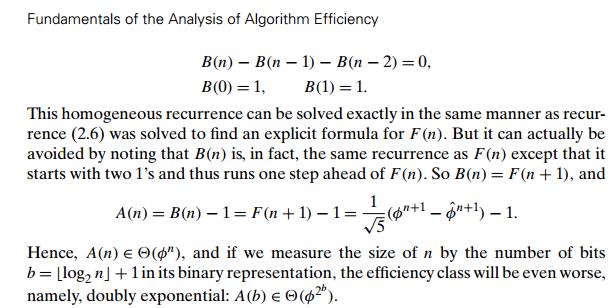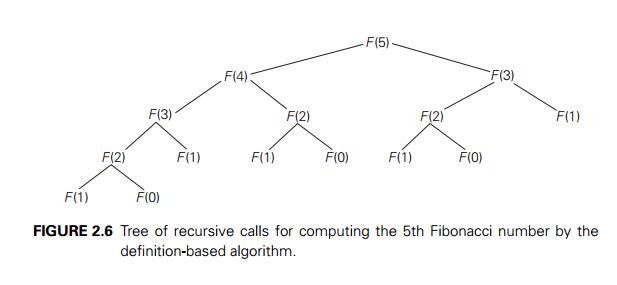Chapter: Introduction to the Design and Analysis of Algorithms : Fundamentals of the Analysis of Algorithm Efficiency
Example: Computing the nth Fibonacci Number
Example:
Computing the nth Fibonacci Number

The
Fibonacci numbers were introduced by Leonardo Fibonacci in 1202 as a solution
to a problem about the size of a rabbit population (Problem 2 in this section’s
exercises). Many more examples of Fibonacci-like numbers have since been
discovered in the natural world, and they have even been used in predicting the
prices of stocks and commodities. There are some interesting applications of
the Fibonacci numbers in computer science as well. For example, worst-case
inputs for Euclid’s algorithm discussed in Section 1.1 happen to be consecutive
elements of the Fibonacci sequence. In this section, we briefly consider
algorithms for computing the nth
element of this sequence. Among other benefits, the discussion will provide us
with an opportunity to introduce another method for solving recurrence
relations useful for analysis of recursive algorithms.
To start,
let us get an explicit formula for F (n). If we
try to apply the method of backward substitutions to solve recurrence (2.6), we
will fail to get an easily discernible pattern. Instead, we can take advantage
of a theorem that describes solutions to a homogeneous second-order linear recurrence
with constant co-efficients

where a, b, and c are some
fixed real numbers (a = 0) called the coefficients of the
recurrence and x(n) is the
generic term of an unknown sequence to be found. Applying this theorem to our
recurrence with the initial conditions given—see Appendix B—we obtain the
formula

that
formula (2.9), which includes arbitrary integer powers of irrational numbers,
yields nothing else but all the elements of Fibonacci sequence (2.5), but it
does!
One of the benefits of formula (2.9) is that it immediately implies that F (n) grows exponentially (remember Fibonacci’s rabbits?), i.e., F (n) ∈ ѳ(φn). This

![]()
![]() In the algorithms that follow, we
consider, for the sake of simplicity, such oper-ations as additions and
multiplications at unit cost. Since the Fibonacci numbers grow infinitely large
(and grow very rapidly), a more detailed analysis than the one offered here is
warranted. In fact, it is the size of the numbers rather than a time-efficient
method for computing them that should be of primary concern here. Still, these
caveats notwithstanding, the algorithms we outline and their analysis provide
useful examples for a student of the design and analysis of algorithms.
In the algorithms that follow, we
consider, for the sake of simplicity, such oper-ations as additions and
multiplications at unit cost. Since the Fibonacci numbers grow infinitely large
(and grow very rapidly), a more detailed analysis than the one offered here is
warranted. In fact, it is the size of the numbers rather than a time-efficient
method for computing them that should be of primary concern here. Still, these
caveats notwithstanding, the algorithms we outline and their analysis provide
useful examples for a student of the design and analysis of algorithms.
To begin
with, we can use recurrence (2.6) and initial conditions (2.7) for the obvious
recursive algorithm for computing F (n).
ALGORITHM F (n)
//Computes
the nth Fibonacci number recursively
by using its definition //Input: A nonnegative integer n
//Output:
The nth Fibonacci number if n ≤ 1 return n
else return F
(n − 1) + F (n − 2)
Before
embarking on its formal analysis, can you tell whether this is an effi-cient
algorithm? Well, we need to do a formal analysis anyway. The algorithm’s ba-sic
operation is clearly addition, so let A(n) be the
number of additions performed by the algorithm in computing F (n). Then the numbers of additions
needed for computing F (n − 1) and F (n − 2) are A(n − 1) and A(n − 2), respectively, and the algorithm
needs one more addition to compute their sum. Thus, we get the following
recurrence for A(n):

The
recurrence A(n) − A(n − 1) − A(n − 2) = 1 is
quite similar to recurrence F (n) − F (n − 1) − F (n
− 2) = 0, but its right-hand side is not
equal to zero. Such recurrences
are called inhomogeneous. There are general techniques for solving
inhomogeneous recurrences (see Appendix B or any textbook on discrete
mathe-matics), but for this particular recurrence, a special trick leads to a
faster solution. We can reduce our inhomogeneous recurrence to a homogeneous
one by rewriting it as
[A(n) + 1] − [A(n − 1) + 1] − [A(n − 2) + 1] = 0
and
substituting B(n) = A(n) + 1

The poor efficiency class of the
algorithm could be anticipated by the nature of recurrence (2.11). Indeed, it
contains two recursive calls with the sizes of smaller instances only slightly
smaller than size n. (Have you encountered such a situation before?) We can
also see the reason behind the algorithm’s inefficiency by looking at a
recursive tree of calls tracing the algorithm’s execution. An example of such a
tree for n = 5 is given in Figure 2.6. Note that the same values of the
function are being evaluated here again and again, which is clearly extremely
inefficient.
We can obtain a much faster algorithm
by simply computing the successive elements of the Fibonacci sequence
iteratively, as is done in the following algorithm.
ALGORITHM Fib(n)
//Computes the nth Fibonacci number
iteratively by using its definition
//Input: A nonnegative integer n
//Output: The nth Fibonacci number
F [0] ← 0; F [1] ← 1
for i ← 2 to n do
F [i] ← F [i − 1] + F [i − 2]
return F [n]

This
algorithm clearly makes n − 1 additions. Hence, it is linear
as a function of n and
“only” exponential as a function of the number of bits b in n’s binary
representation. Note
that using an extra array for storing all the preceding ele-ments of the
Fibonacci sequence can be avoided: storing just two values is neces-sary to
accomplish the task (see Problem 8 in this section’s exercises).
The third
alternative for computing the nth
Fibonacci number lies in using formula (2.10). The efficiency of the algorithm
will obviously be determined by the efficiency of an exponentiation algorithm
used for computing φn. If it is
done by simply multiplying φ by
itself n − 1 times,
the algorithm will be in (n) = (2b). There
are faster algorithms for the exponentiation problem. For example, we will
discuss (log n) = (b)
algorithms for this problem in Chapters 4 and 6. Note also that special care
should be exercised in implementing this approach to computing the nth Fibonacci number. Since all
its intermediate results are irrational numbers, we would have to make sure
that their approximations in the computer are accurate enough so that the final
round-off yields a correct result.
Finally,
there exists a (log n) algorithm for computing the nth Fibonacci number that
manipulates only integers. It is based on the equality

and an
efficient way of computing matrix powers.
Exercises 2.5
1. Find a Web site dedicated to applications of the Fibonacci numbers and study it.
2. Fibonacci’s rabbits problem A man put a pair of rabbits in a place sur-rounded by a wall. How many pairs of rabbits will be there in a year if the initial pair of rabbits (male and female) are newborn and all rabbit pairs are not fertile during their first month of life but thereafter give birth to one new male/female pair at the end of every month?
3. Climbing stairs Find the number of different ways to climb an n-stair stair-case if each step is either one or two stairs. For example, a 3-stair staircase can be climbed three ways: 1-1-1, 1-2, and 2-1.
4. How many
even numbers are there among the first n
Fibonacci numbers, i.e., among the numbers F
(0), F (1),
. . . , F (n − 1)? Give a closed-form formula
valid for every n > 0.

6. The maximum values of the Java primitive types int and long are 231 − 1 and 263 − 1, respectively. Find the smallest n for which the nth Fibonacci number is not going to fit in a memory allocated for
a. the type int.
b. the type long.
7. Consider the recursive definition-based algorithm for computing the nth Fi-
bonacci
number F (n). Let C(n) and Z(n) be the number of times F (1) and F (0)
are
computed, respectively. Prove that
C(n) = F (n).b. Z(n) = F (n − 1).
8. Improve algorithm F ib of the text so that it requires only (1) space.
9. Prove the
equality

10. How many modulo divisions are made by Euclid’s algorithm on two consec-utive Fibonacci numbers F (n) and F (n − 1) as the algorithm’s input?
11. Dissecting a Fibonacci rectangle Given a rectangle whose sides are two con-secutive Fibonacci numbers, design an algorithm to dissect it into squares with no more than two squares being the same size. What is the time efficiency class of your algorithm?
12. In the language of your choice, implement two algorithms for computing the last five digits of the nth Fibonacci number that are based on (a) the recursive definition-based algorithm F (n); (b) the iterative definition-based algorithm Fib(n). Perform an experiment to find the largest value of n for which your programs run under 1 minute on your computer.
Related Topics